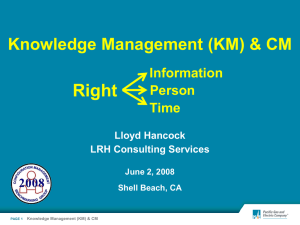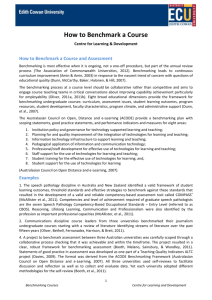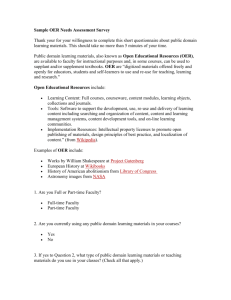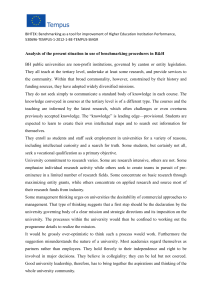Bacsich Massey final
advertisement
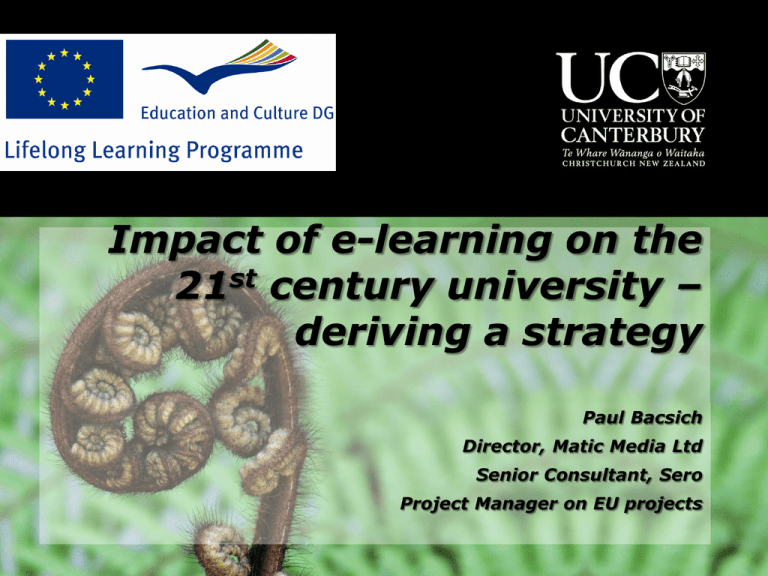
Impact of e-learning on the 21st century university – deriving a strategy Paul Bacsich Director, Matic Media Ltd Senior Consultant, Sero Project Manager on EU projects Paul Bacsich - general Former Research Director, Re.ViCa – virtual campuses Benchmarking Consultant, Higher Education Academy (4 phases) Project Manager, POERUP – national policies for OER uptake Visiting Fellow, University of Canterbury DEANZ conference Keynote on 11/4/12 Have advised Chester, Glamorgan, Aberystwyth, Gotland, KTH, OU and AOU “Spaghetti junction” for universities Broad or narrow focus? Lack of clarity on purpose – national and for students/parents Retention Funding Effectiveness Research – role, funding and relevance to teaching Will foreign students continue? And why? When will the “rite of passage” become too costly? Analytic methodologies Comparative education (countries then institutions) Benchmarking (institutions or groups of institutions) Costs and time studies Types of Higher Education Institution (Europe) University (typically old) University of Applied Sciences (typically new, less oriented to higher degrees) – former polytechnics University college College (on margins) Diagram of UNESCO ISCED taxonomy 5A - uni 5B – poly 4 - college 3 – upper secondary school 2 – lower secondary school A world tour... Virtual universities/polytechnics (outside NZ) Definitions: Virtual = more or less fully distance Hybrid = mostly distance, some f2f (eg Saturday schools, study centres, etc) Dual-mode = “half” is virtual, other half f2f Virtual universities Teaching all (or almost all) at a distance: Many countries have a “state” single-mode provider – an open university Many countries eg UK, Australia, Canada etc – in fact most – have many other dual-mode providers VUs go well beyond OECD and BRIC, right across Latin America, Middle East (AOU), Iran, China (in profusion), Japan less so but growing fast, patchy across Europe Failures UK e-University Scottish Knowledge, Interactive University Most university e-learning consortia Dutch Digital University Many US virtual university consortia Partial successes NKI but clouds gathering DL in trouble across the world (President of ICDE) – Latin America, UK, Sweden, NZ, etc Many DL operations within UK universities never achieve “second stage ignition” The Campus does not “wither away” Dutch Ou – more than one Houdini episode But some Canadian organisations reconfigure and then thrive – TechBC>SFU, OLA>TRU Successes UKOU (discuss) Open Universities Australia (discuss – only consortium that works) Several other Australian unis Too soon to tell: OER u A more granular analysis BENCHMARKING Benchmarking in tertiary education: the five systems eMM (NZ, Australia, UK) – you know well Pick&Mix (UK, Sweden, EU – bit in Canada) ACODE (Australia mainly) – current work? E-xcellence (EU only) Quality Matters (QM) (US) – hard to break in See http://www.virtualcampuses.eu UK experience of benchmarking e-learning Higher Education Academy (like Ako A or ALTC) funded four phases of benchmarking Across 82 institutions using five systems Including PnM and eMM – other three have died or been subsumed Pick&Mix continues as a commercial activity in UK and Sweden and as part of EU projects (Re.ViCa and VISCED) now and to come eMM recent phase in NZ just completed Distance Learning Benchmarking Club (Pick&Mix) Ran from 2009-2011 Members were: University of Leicester (UK) – founder Thompson Rivers University (Canada) – dual-mode Lund University (Sweden) KTH (Sweden) University of Gotland (Sweden) – dual-mode, late entrant Drop-outs for various reasons: Liverpool, USQ (Australia) and a NZ university Results also correlated with Liverpool John Moores and University of Northampton Weak areas: from Pick&Mix benchmarking and the DLBC Cost analysis Market research (all except TRU) Staff reward and recognition Accessibility Note that in UK Pick&Mix was chosen mainly by institutions active in e-learning operationally who wanted to improve their provision Big DL providers in UK apart from OU London External Leicester Staffordshire, Derby Wales: Glamorgan only Scotland: Robert Gordon?, Heriot Watt? Many others have “faded” or were minimal Ufi sold off, declining Colleges doing essentially nothing or fading Several virtual high schools and A level providers Costs Why is so little work done on costs of learning? Outside the US, in many countries there is no overall articulated and evidenced case for blended learning on-campus that is acceptable to “full time” students yet cost-effective long term in the days of adversity Retention A problem in universities in many countries Usually worse when distance learning and/or adult students are involved Often not so much of a problem to the students as the universities or Ministry Because students may want to exit and maybe return later – or use part-qualifications as entry to a job New developments such as content-rich courses and modular funding are likely to make it worse But OER may improve things! Quality Often used to avoid issues, not solve them Close link with benchmarking (ENQA talk) Do need a special scheme for e-learning but correlated with general guidelines for nation and global schemes Institutional guidelines too No need for separate scheme for OER – and no energy for one in most institutions (note to OER u) The quality pyramid (for ENQA) Critical Success Factors ------ Leadership level Benchmarking ------------------ Senior managers Quality --------------------------- QA mgrs Detailed pedagogic guidelines ----------------------- Criteria are placed at different layers in the pyramid depending on their “level” Effectiveness and study time “Academically Adrift” in US and some similar UK work suggests that students come out of university with analytic skills not much better than those they came in with In a nutshell, they do not do nearly enough reading and writing of long assignments – as they used to In England, student study times have dwindled and vary wildly between institutions and courses (HEPI, OU for HEFCE) – much lower than in rest of Europe and for a 3-year BA Hons Crudely, there are no full-time students any more in UK (in a diffident way) SUGGESTIONS Study time Do studies on study time to ensure that students, parents and ministers are not shortchanged Part of “knowing your students” (now and in future) – see later Can the NZ 4-year honours programme resist for long the pressure to make it 3-year as in England? To do a 4:3 compression would likely require e-learning Effectiveness – make them think Reconceptualise assessment (good idea anyway) Ensure students can assimilate large amounts of information, analyse it and communicate their conclusions verbally, and in printed reports and presentations, to the satisfaction of employers Applies to all subjects in relevant ways Know your current and future students There is always a role for market research techniques – especially when students pay fees but even when the state pays all costs (as then one is competing with other HEIs for government funding) Student satisfaction is only one dimension of understanding students Must also understand their life-situation Research-teaching links Research has value for the nation but not necessarily for all students/courses/institutions The elite universities have so far managed to avoid any detailed analysis of the researchteaching synergies – but can this last? More studies are needed on the finances of tertiary institutions and to what (non-teaching) purposes student- and other moneys are put (cf. TRAC in UK) The “research institute” (separate institution) model might be worth detailed investigation Breadth The evidence from the for-profit sector suggests that breadth of provision beyond “traditional” HE is key to success of e-learning But can this be a route for research-led institutions (RLIs) under the cosh of PBRC There is a role for specialised institutions (e.g. art & design, though many are being absorbed) but narrowing is often a “weak move” Should RLIs mentor/own specialised institutions including more vocational ones? Look at UTCs Vision: The Multeversity 5A 5B 4 3 keynote Multeversity features. Broad-spectrum yet full university range of work/features Multi-mode according to student demand: pure DL, hybrid e/f2f, trad f2f+e (if really justified); multi-site if need be Highly cost-aware yet transparent to clients Covers poly and college areas which are synergistic (e.g. Cisco Academy, fashion design) Bridges into and from upper secondary school, so as to minimise drop-out and leverage on schools-level knowledge Generates “liberal arts” thinkers (in all fields) yet who are “(e-)business-ready” Links with international partners to lobby governments Joins with other unis/entities to control school-leaving exams.. Discussion.... Paul Bacsich Re.ViCa/VISCED/POERUP Canterbury Visiting Fellow PS 1: Key URLs http://www.virtualcampuses.eu/index.php/Re.ViCa http://www.virtualschoolsandcolleges.eu http://www.virtualschoolsandcolleges.info/project/outcomes http://poerup.referata.com/wiki/POERUP (OER) http://www.mendeley.com/profiles/paul-bacsich/ PS 2: Comparative ICT in learning – phases of Paul’s research 1995: US 3-week tour with Robin Mason, for UKOU 1996: Finnish govt support for RA 6-month study (1997-1999: developing a Virtual Campus) 2000-2005: e-University country/provider studies 2007-2009: EU Re.ViCa (virtual campuses) 2009: Becta international and other reports 2010: studies for UKOU on retention and on VLEs 2011-2013: VISCED (virtual schools and colleges), then POERUP (OER policies) PS3: Sources: specific papers and studies Virtual Campus Handbook, 2009 (Re.ViCa) “Impact of E-Learning on the 21st Century University”, book chapter in International Perspectives on Higher Education: Changing values & practice (ed. Trevor Kerry), Continuum Books, May 2012 “Time and microlearning”, Microlearning 2011 Student Retention and the Value of Higher Education (with Ormond Simpson), 2010, for OU Distance Learning Benchmarking Club
